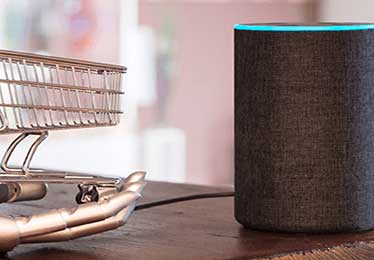Speech Recognition Technology and Its Applications in Sales


Voice commerce has arrived. Today, retailers can sell products by designing experiences that leverage speech recognition technology and its capabilities.
According to Meticulous Research, wthe speech recognition market is forecasted to be worth approximately $26.79 billion by 2025 (growing at a CAGR of 17.2%). The number of voice assistants used around the world is also expected to reach a whopping 8.4 billion by 2024.
As such, speech recognition technology, like the dotcom boom, is well-placed to create a new avenue for sales teams around the planet. But before we get ahead of ourselves, let’s first define it.
Read moreDevelopment (history) and applications of speech recognition systems

Walking into many houses around the world, you’re likely to find one or perhaps more ubiquitous little speakers, scattered around. For the residents of these homes, these devices have become a key part of their lives, sharing details about meetings, travel plans, grocery lists and even weather reports. We’ve come to depend on them to help simplify our lives and entertain us.
Read moreUses of Speech Recognition Systems for Disabled Persons

Today, thanks to technological advances, many disadvantaged and disabled individuals are able to use technology to make their lives easier and more livable. One promising area is speech recognition. This technology is at the heart of personal voice assistants like Siri, Amazon Echo, and Google, that we’ve become accustomed to using either on our smartphones or through a smart speaker in our home.
Read moreSpeech recognition in our everyday life

Over the course of the past decade, the world has gone through a radical transformation. Technologies that were once something popularized by science fiction have now become a facet of our daily life. One technology that has now become so commonplace, most don’t even give it a second thought is speech recognition.
Nowadays, AI powered voice assistants like Alexa, Siri and Google are scattered throughout our homes and smartphones – but it wasn’t always this way. For quite a long period of time, voice control was very hit and miss.
Read moreAI Data Set creation, labeling and verification, and its importance for Machine Learning & Artificial Intelligence (AI)

Data scientists continue to work tirelessly to try and replicate human intelligence through the algorithms they create.
Neural networks are systems with autonomous or intelligent behavior. They are able to perform tasks and solve problems independently (so-called artificial intelligence / AI). Before that, the neural algorithms have to be trained using sample data. AI systems learn from these data and can generalize them and apply what has been learned to new tasks.
The more accurate and extensive the amount of AI training data is, the better the first results of AI systems are.
Does Artificial Intelligence Optimize Human Beings?

The concept of the perfect human is as old as humanity itself. But self-learning algorithms are bringing the realization of this idea a little closer now, just as they entail the fear of the omnipotence of machines. Does artificial intelligence make us smarter, better looking, healthier and happier? Four questions and four answers.
Read moreDoes Artificial Intelligence benefit the Common Good?

The invention of the steam engine triggered revolutionary societal changes. Machines replaced physical work. They produced goods cheaper, faster and more effectively. In the end everyone profited from that through more prosperity. A similar development is becoming apparent today: in many areas artificial intelligence is replacing processes which require human thinking. Will we also all benefit from this?
Read moreChoosing the right AI model

The popularity of AI (Artificial Intelligence) systems is growing in leaps and bounds. Businesses around the world are starting to understand how these systems can benefit them, but AI is not yet at the stage where you can simply take it out of the box and expect it to perform. AI systems require training, which is where AI models come into the equation.An “AI model” is an algorithm that is taught using data and input from a human expert. The model is evaluated on its accuracy by comparing the results it provides against the decisions made by the human expert. This often requires the algorithm to review a significant amount of data. In addition, by accessing data from multiple sources, the model is better able to find patterns which it can use to further streamline its analysis. The model is attempting to replicate the decision process of a team of experts with access to the same data. Understanding the intricate process of AI training is crucial for companies aiming to deploy efficient AI models.
Read moreArtificial Intelligence in Germany

Artificial intelligence is changing the world. There is no doubt about it. Self-learning algorithms are now being developed all over the world and an increasing number of economies are focusing on promoting AI development at a domestic level. Machine learning benefits mankind all over the world – individual countries profit from it. But what is the current status of artificial intelligence in Germany? Can German AI development compete on an international level? And what about state subsidies?
Read moreTypes and Importance of AI Training Data

1997 was a pivotal year in the world of Artificial Intelligence (AI) as it was the first time a machine managed to defeat a world champion in chess. Deep Blue was an IBM Supercomputer and, after losing to Garry Kasparov 4-2 in 1996, had learned and improved and came back to defeat him in 1997 after a hard-fought battle.
Machine learning (ML) and AI use complicated algorithms to learn and process information. These algorithms mimic the human brain, and just like a human child learns, they can also be taught through data and experience.
Read more

